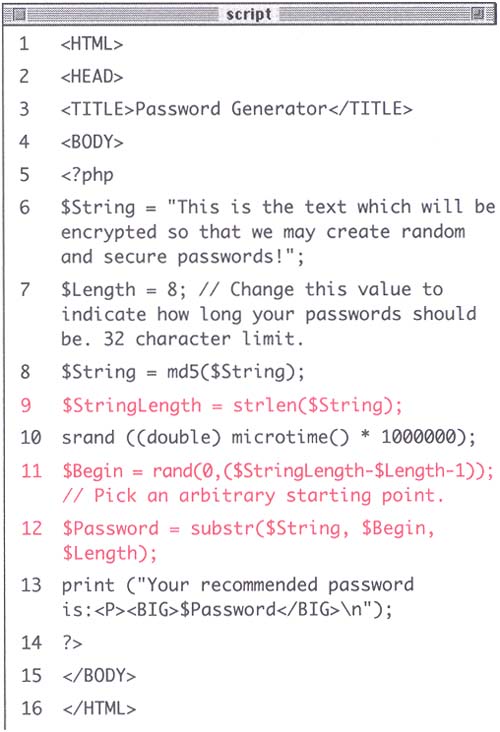Pulling Out Parts from a String
| I l @ ve RuBoard |
| Earlier in this chapter you learned how to join strings together using concatenation. Besides making larger strings out of smaller pieces, you can also extract subsections of a string. There are a number of built-in functions that can do this in different ways, and I'll cover two here. The trick to using any method to pull out a subsection of a string is that you must know something about the string itself in order to do so effectively. The strtok () function creates a sub-string, referred to as a token, from a larger string based upon a predetermined separator (a comma or a space, perhaps). For example, if you have users enter their full name in one field (presumably with their first and last names separated by a space), you could ascertain their first name with the code: $FirstName = strtok($Name, " "); where $Name is the name of the variable received from the form which contains the user 's full name. This line of programming tells PHP to pull out everything from $Name up until it finds a blank space. If you had the user enter their full name in the format of "LastName, FirstName", you could find their surname by writing: $LastName = strtok($Name, ","); Since you have wisely kept the two names distinct in your form, you will not need to use this function at this time. A second way to pull out sections of a string is by referring to the indexed position of the characters within the string. When I refer to the index of a string, I mean the numerical location of a character, counting from the beginning. However, PHPlike most programming languagesbegins all indexes with the number 0. So to index the string "Larry," you would begin with the "L" at position 0, "a" at 1, "r" at 2, the second "r" at 3, and the "y" at 4. Even though the string length of "Larry" is 5, its index goes from 0 to 4. With this in mind, you can utilize the substr() function to create a sub-string based upon the index position of the sub-string's characters, like this: $SubString = substr($String,0,10); First, you must enter in the master string from which your sub-string will be derived (here, $String). Second, you indicate where the sub-string begins, as its indexed position (0so you want to start with the first character). Third, you determine how many characters, from that starting point, the sub-string is composed of (10). If, in this case, $String is not 10 characters long, the resulting $SubString will end with the end of $String. Frequently you'll use the strlen() function to help determine the ending point of the string. This function calculates how long a string is (i.e., how many characters is contains) and is very easy to use: $StringLength = strelen($String); You'll use the notion of substr(), along with strlen(), and md5(), to write a nifty password generation program. Passwords you use are more secure the more random they are. In fact, passwords which have no special meaning, are not based upon common words, and use a variety of upper- and lowercase letters and numbers are the most secure of all. This script will create a new, random password each time you reload the page. To create a password generator in PHP:
Tip Instead of setting the $Length variable at the onset of our page, you could use the URL/GET trick to send the page a length value by appending ?Length=8 to the URL (if you do so, then be sure to remove line 7). Tip Databases have a date format which stores calendar dates as YYYY-MM-DD (or something similar to this). Since you would know the exact format of the string retrieved from the database, the sub-stringsyear, month, and daycould be calculated using substr(): $Year = substr($Date,0,4); $Month = substr($Date,5,2); $Day = substr($Date,8,2); Tip Using strlen() is definitely a situation where you absolutely do not want to write $Password = strlen($Password);, in which case you would replace the actual password value with a number indicating how many characters were once, but are no longer, in the variable ! |
| I l @ ve RuBoard |
EAN: 2147483647
Pages: 116


